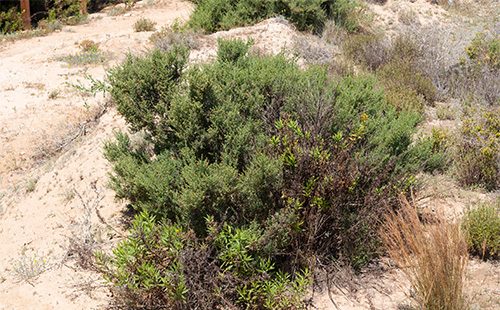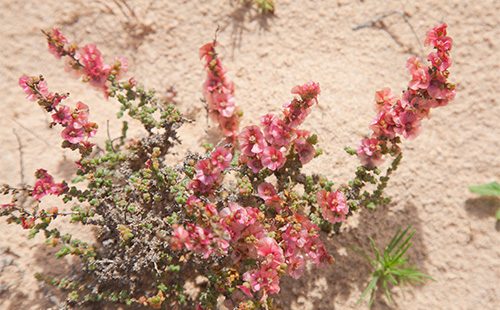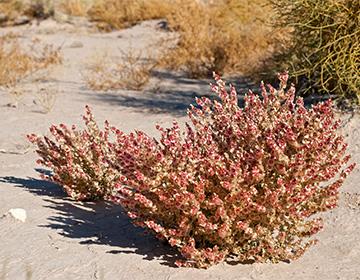The content of the article
The grass is respected among oriental physicians. However, in domestic medicine, she lost ground to Richter's hodgepodge, since the therapeutic potential of this type is considered by scientists as more powerful.
Botanical characteristic
The name culture got for its salty taste. Developing, the plant accumulates a huge amount of minerals. It grows on pastures, wastelands, near cereal fields. When dried, hardens and rolls under the gusts of wind on the plains, like a ball, for which it is called tumbleweed. The tangle itself, the diameter of which varies from 30 cm to 1 m, is covered with many thorns. Hence another popular name - the Tatar thistle. It grows well on sandy and clay soils, salt marshes. Distributed culture in the southern regions of Russia.
Solyanka hill belongs to grassy annuals. Before the plant hardens, it looks as follows.
- Underground part. The root system of the rod type. The central root penetrates deep into the soil, many thin lateral roots develop from it.
- The stalks. Soft green stems of cylindrical shape multiple depart from the central root. As they develop, they intertwine. The surface is smooth, covered with pinkish veins.
- Leaves. Two types of leaves are formed on the stems. The first ones are soft, semi-cylindrical, light green in color, rather large (up to 6 cm long). After their falling, rigid shortened sheets (up to 1.5 cm long) with an expanded base and a leathery surface appear. There are thorns near each.
- Flowers. White-green with a pink tint. Multiple collected in spike inflorescence.
- Fruit. Cone-shaped achenes ripen in August, after the plants bloom. Easy to drop out of nests.
Harvesting raw materials
Medicinal raw material is the grass of the plant - leafy shoots collected before the flowering phase.
- Collection. Protecting hands with gloves, using a secateurs cut off the aerial part of completely green plants. Collection is carried out after leaf renewal.
- Training. It is necessary to lay out grass on the litter directly in balls - this way it dries better.
- Drying. For drying, shaded areas are suitable, preferably with through ventilation.
Completely dry balls are crushed, folded into linen or paper bags. Raw materials are stored by hanging containers in a ventilated, dry, dark place.
Composition
Tatar thistle is especially appreciated for its mineral content. The most impressive concentrations are salts of magnesium, potassium, calcium and silicon. They are necessary for the proper course of metabolic processes, the production of enzymes and hormones. The composition contains other beneficial substances.
- Fatty acid. They participate in metabolic processes, they are necessary for the production of protective cells, the construction of cell membranes, and they reduce the content of low density lipoproteins in the blood.
- Polysaccharides. The most useful are inulin and manan. These are high molecular weight compounds with hypoglycemic action. Polysaccharides also contribute to the normalization of intestinal microflora.
- Phenol Carboxylic Acids. Stimulate secretion, have antimicrobial and anti-inflammatory properties.
- Antioxidants. These are vitamins E, A, C, whose action is enhanced by other biologically active substances. They neutralize free radicals, preventing cell damage and premature aging. They also normalize oxygen consumption by cells.
- Saponins. They have an expectorant effect, normalize the functioning of the nervous system, stimulate the secretion of bile and urine.
- Flavonoids. Represented by quercetin, isoramnetin, tricin. These substances stimulate cell renewal, regeneration processes, and bile production. They also normalize the permeability of the capillary walls, optimize vascular tone, and prevent varicose veins.
- Glycosides. Positively affect the state of the nervous and cardiovascular systems. Regulate pressure, heart rate, have a mild sedative effect.
- Amino acids. Represented by betaine and glycine. The first amino acid is useful for metabolism in liver cells; it triggers the renewal and restoration of hepatocytes. Glycine normalizes the conductivity of nerve fibers, regulates the processes of excitation and inhibition in the brain, and establishes mental activity.
- Phytosterols. They are able to stimulate the formation of hormones, have lipotropic activity - they regulate the ratio of beneficial and harmful triglycerides in the body, and prevent atherosclerotic vascular damage.
Alkaloids of the isoquinoline series have also been identified. These substances are able to lower pressure and stop the pain syndrome, however, for this their concentration in the plant is not enough.

Healing properties
The main field of application of the Tatar thistle is the treatment of liver diseases. Plant preparations stimulate the renewal of hepatocytes, restore trophism of the hepatic parenchyma and its utilization function. Due to this, toxins are intensely removed from the patient's body. A positive effect on hepatocytes entails a second effect - improving the formation and excretion of bile, which prevents gallstone disease, dyskinesia, and digestive disorders.
Together with bile, fatty acids that regulate the composition of the blood - the content of triglycerides and sugar - enter the digestive tract. Therefore, the grass can be used for atherosclerosis and diabetes. Also, the plant stimulates the formation of enzymes, improves absorption in the intestines, eliminates flatulence and abdominal cramps. In the form of dietary supplements and extracts, the plant is prescribed for:
- infectious hepatitis;
- intoxication;
- initial forms of cirrhosis;
- congestion in the bile;
- gastric and duodenal ulcer;
- fatty degeneration of the liver;
- complex helminthic infestations;
- living in adverse conditions.
The ability of a hodgepodge to affect metabolism allows it to be used for obesity, as well as to stimulate weight loss when stopping weight on a specific indicator. It is believed that tumbleweeds activate the combustion of internal and subcutaneous fat to provide energy to metabolic processes. There are other indications for the use of herbal remedies.
- The kidneys. The plant has anti-inflammatory, antimicrobial, antispasmodic and diuretic effects simultaneously. As a result, it helps to treat acute and chronic inflammatory pathologies of the urinary system, and also prevents the appearance of stones and sand in the kidneys.
- Oncology. Healers recommend using herbal remedies to those people who live in an unfavorable environmental situation. The grass creates cancer prevention and helps in the treatment of existing pathologies. As an active antioxidant, it prevents premature aging and the development of chronic diseases.
- The cardiovascular system. The Tatar thistle has cardioprotective properties - it regulates the strength and heart rate, blood pressure indicators. Due to the strengthening of blood vessels, it normalizes peripheral blood flow and prevents internal and external capillary bleeding.
- Immunity. Nutrients give grass immunostimulating and general strengthening properties. The plant regulates the activity of the body's defenses, accelerates the recovery process after physical and mental stress, helps to rehabilitate after exhaustion.
Herbal preparations are recommended for the prevention of immune disorders, diabetes mellitus, malignant diseases, premature aging of the body.
Prescription Drugs
A number of drugs are produced industrially from a plant. In the pharmacy assortment you can find "Hill Solyanka extract" in capsules, tea bags, as well as the following drugs:
- Lohein - granules for oral administration, drink two pieces up to four times a day;
- Extracol - also a granular preparation, before taking a teaspoon of the drug is dissolved in water;
- Solyanka Liquid Extract- take 5-10 ml up to three times a day, the preventive dose - 15 drops daily for up to two months;
- Hepatosol- a preparation for cleaning the liver in the form of a powder, which is dissolved in water before administration;
- Askohol- a drug with extract of hodgepodge and ascorbic acid, produced in the form of instant tea in different packaging.
Having medicinal raw materials independently collected in an environmentally friendly place, preparations can be prepared at home. It is undesirable to buy grass from your hands - unscrupulous people are already collecting dry lumps along roadsides. There is no use in such raw materials.
Decoction
Features The product has diuretic, diaphoretic, cleansing properties. Stimulates digestion and relieves inflammation.
Preparation and use
- One and a half tablespoons of chopped herbs is poured into a cup of hot boiled water.
- Put the container on fire, bring to a boil, simmer for ten minutes under the lid.
- After cooling, the extract is filtered.
- Take orally after eating a tablespoon three times a day.
Infusion
Features The tool is used for preventive purposes, as well as to improve vision. It is believed that the infusion regulates intraocular pressure, increased with glaucoma.
Preparation and use
- One and a half tablespoons of raw materials are poured into a thermos.
- Pour a cup of boiling water.
- Cork the vessel tightly and leave to insist for a couple of hours, shaking occasionally.
- After filtering, take orally in a tablespoon three times a day.

Tincture
Features Tincture can be used as a hepatoprotective agent, for cleansing with intoxication and disease prevention.
Preparation and use
- A tablespoon of raw materials in a glass container is poured into 100 ml of vodka or diluted alcohol.
- Tightly close the container, put in a dark place for two weeks. The bottle is shaken periodically.
- After the expiration of the infusion, the product is filtered. Take 20 drops three times a day, dissolving them in a glass of clean water.
Phyto-raw materials are also used in cosmetology - for skin and hair care. Ice cubes are made from the broth, with which they rub their face daily. It helps with acne, tones, promotes rejuvenation. With a water extract, rinse the strands to eliminate fat content and improve growth. Ready-made tanning products with hodgepodge extract are on sale.

